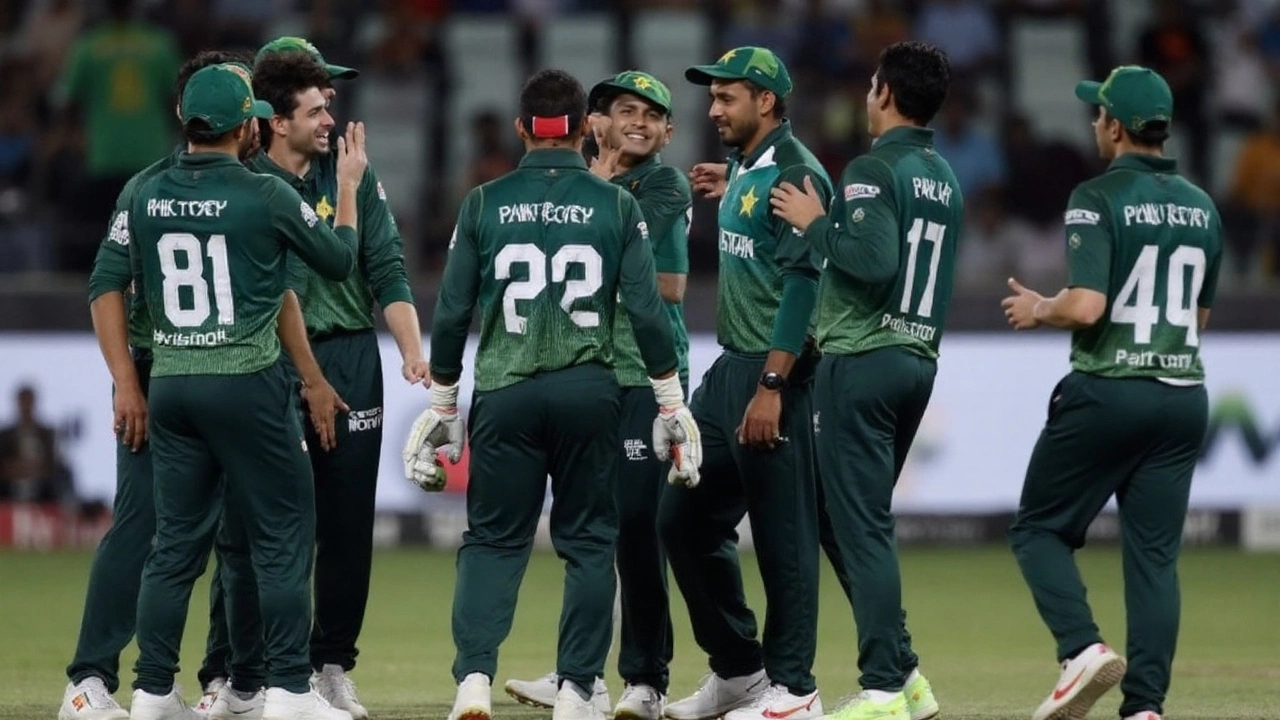Haris lights up Dubai as Pakistan roll Oman by 93 runs
Packed night, sharp lights, and an uneven pitch that kept bowlers interested—Pakistan turned all of that into a statement win. In the 4th T20 of the Asia Cup 2025 at Dubai International Cricket Stadium on September 12, Pakistan beat Oman by a huge 93-run margin to climb to second in the group, behind India on net run rate. The game started at 8:00 PM local time, with Salman Ali Agha winning the toss and batting first. By the end, Oman were bundled out for 67, chasing 161.
This was a clinical, no-frills performance from a side that recently lifted a UAE Tri-Series, where Mohammad Nawaz stole headlines with a five-for and a hat-trick in the final against Afghanistan. The confidence from that week showed again. Pakistan read the surface well, batted with intent early, adapted when the pitch slowed, and then applied the squeeze with ball in hand.
The centerpiece was Mohammad Haris. Coming in after a steady start from the openers, he changed the tempo without getting reckless. His 66 off 43 balls—seven fours and three clean sixes—was the one innings that looked in total control of the night. He picked the gaps square, used the crease smartly to counter the slower balls, and punished anything short. On a track that made big hitting tricky later on, that knock set the tone and eventually the margin.
Pakistan’s top order, led by Saim Ayub and Sahibzada Farhan, went hard early but didn’t overreach. Once Oman took pace off and held their lengths, Fakhar Zaman and captain Salman Ali Agha focused on strike rotation. It wasn’t flashy, but it was smart. The innings never ballooned out of control, nor did it stall. The 160/7 Pakistan finished with felt about 15 runs above par given how the pitch behaved after the powerplay.
Oman’s response with the ball deserves a nod. Aamir Kaleem and Shah Faisal were the standouts, taking three wickets each. They denied Pakistan a late-overs launch with good use of cutters and wider lines. Kaleem kept Pakistan’s middle stuck between push and risk; Faisal handled the death with calm, forcing mishits instead of yorker-chasing heroics. On another night, that containment might have dragged the target down into the 140s.
Once the chase started, the difference in depth hit hard. Oman never settled. The new ball held up just enough and Pakistan’s seamers hit a hard length to make strokeplay miserable. It wasn’t about blasting batters out; it was about denying them any driveable length. Dot balls mounted, the run rate crept, and the mistakes came in a rush.
Faheem Ashraf was the early handbrake, using the angle to tuck batters up and nip the ball off a tight seam. Sufiyan Muqeem took the pace off at the right moments, and Saim Ayub’s part-time overs added a surprising twist—he chipped in with two wickets to cap a strong all-round night. Oman were out for 67, which tells its own story: very little timing, almost no release shots, and not enough partnerships to even hint at a chase.
Pakistan didn’t need Shaheen Afridi and Haris Rauf to be headline-makers to control the game. Their presence and early overs set the tone. The surface in Dubai had some grip, and Pakistan’s bowlers went body-line smartly, into the pitch, cutting off shuffles across the crease. When Oman tried to fetch from outside off, edges and skiers followed. When they waited, the dots piled up. It was a tactical squeeze, not a blitz, and it worked.
For Oman, the night split in two. With the ball, there was belief and some bite. Kaleem and Faisal gave them a foothold, finding a way to stall Pakistan’s charge at the back end. In the field, the energy was there too. But with the bat, they lacked a platform. On these slowish Dubai decks, you need one batter to bat deep, and that anchor never arrived. Pakistan kept the squeeze on, and once wickets fell in clusters, recovery felt out of reach.
Haris’s knock will get the headline font, and it should. The timing and shot selection lifted Pakistan past a middling total into a winning one. Just as important was the refusal to panic when Oman’s bowlers grabbed control late. Instead of swinging blindly, Pakistan played the angles, nudged for twos, and kept the total moving. That maturity is what carries teams through tight group stages.
Context matters too. Pakistan came into the Asia Cup off a Tri-Series win in the UAE, beating Afghanistan by 75 runs in the final—a game where Mohammad Nawaz bagged a dream spell, including a hat-trick. That kind of recent success has a way of steadying selection calls and role clarity. You can see it in how the lineup is set: Saim Ayub and Sahibzada Farhan up top, power hitters and stabilizers in the middle with Fakhar Zaman and Salman Ali Agha, and a bowling mix that lets them adapt to what Dubai throws up—Shaheen Afridi’s strike threat, Haris Rauf’s pace, plus spin from Abrar Ahmed and Nawaz with Muqeem providing variety.
One small subplot was Saim Ayub’s bowling contribution. He’s in the XI for his hitting, no debate there, but those few overs had weight. In tournaments like this, the part-timer who buys two wickets can be as valuable as a frontline spell. It unlocks matchups, saves the main quicks for key phases, and lets the captain push the field around with confidence.
The conditions did their quiet work. Even under lights, the pitch offered grip for anything rolled in at 120–130 kph, and the ball didn’t always slide on. That explains the stop-start nature of Pakistan’s innings after a bright powerplay and why Oman’s chase never found rhythm. The bowlers who leaned into cutters and into-the-pitch lengths got paid. Pakistan, with more options in that space, simply extracted more from the surface for longer.
For Oman, there are positives to pocket. The discipline with the ball against a stronger batting unit will translate in their next outing. Aamir Kaleem’s three-for against a top lineup is no small feat, and Shah Faisal’s death overs showed nerve. They’ll know the batting template needs a reset: take fewer risks early, run harder through the middle, and keep a set batter for the last five. On this ground, 135–145 can be defendable if you bowl to the square boundaries and keep your pace-off plans tight.

What it means for the table—and the India game
The 93-run win puts Pakistan second in Group A on net run rate, sitting just behind India. That math matters now. With two group games in quick succession at the same venue, momentum is currency, and Pakistan just banked a lot of it.
Next up is India on September 14 in Dubai, same lights, same square, but a different pressure. Pakistan will want their top three to cash in again, because India’s new-ball spells are likely to be tighter and the catching sharper. Expect Pakistan to stick to the same template: front-load intent, keep wickets in hand for overs 13–17, and then chase the extra 10–15 with calculated risk at the death.
Selection-wise, there’s little reason to tinker after a performance like this. The balance looks right, the roles make sense, and the bowling combinations let Salman Ali Agha attack with fields rather than defend with them. If there’s a tweak, it could be around who bats at No. 6 to manage the end overs depending on conditions. But if the surface mirrors this one, Pakistan’s mix is already tuned to it.
India bring a different challenge—more batting depth, more experience under pressure—but the conditions will narrow gaps. Spinners and change-ups will be in business again. That’s where Abrar Ahmed and Mohammad Nawaz come into play, alongside the middle-overs control of Muqeem. And if the powerplay swings for a few overs, Shaheen Afridi’s first spell becomes the game’s hinge.
One thing is clear: this was not just a routine win. It was Pakistan landing their game plan with minimal fuss. Haris gave them the score. The attack made it feel 20 runs bigger. And with the India game two days away at the same venue, the rhythm of the night—quick wickets, disciplined lengths, calculated hitting—could not have been better timed.
For fans tracking the tournament, mark the note: Pakistan vs Oman was a one-sided show, but it said plenty about Pakistan’s intent and balance. If they carry this form into Saturday, we’re in for a heavyweight contest under the Dubai lights.
